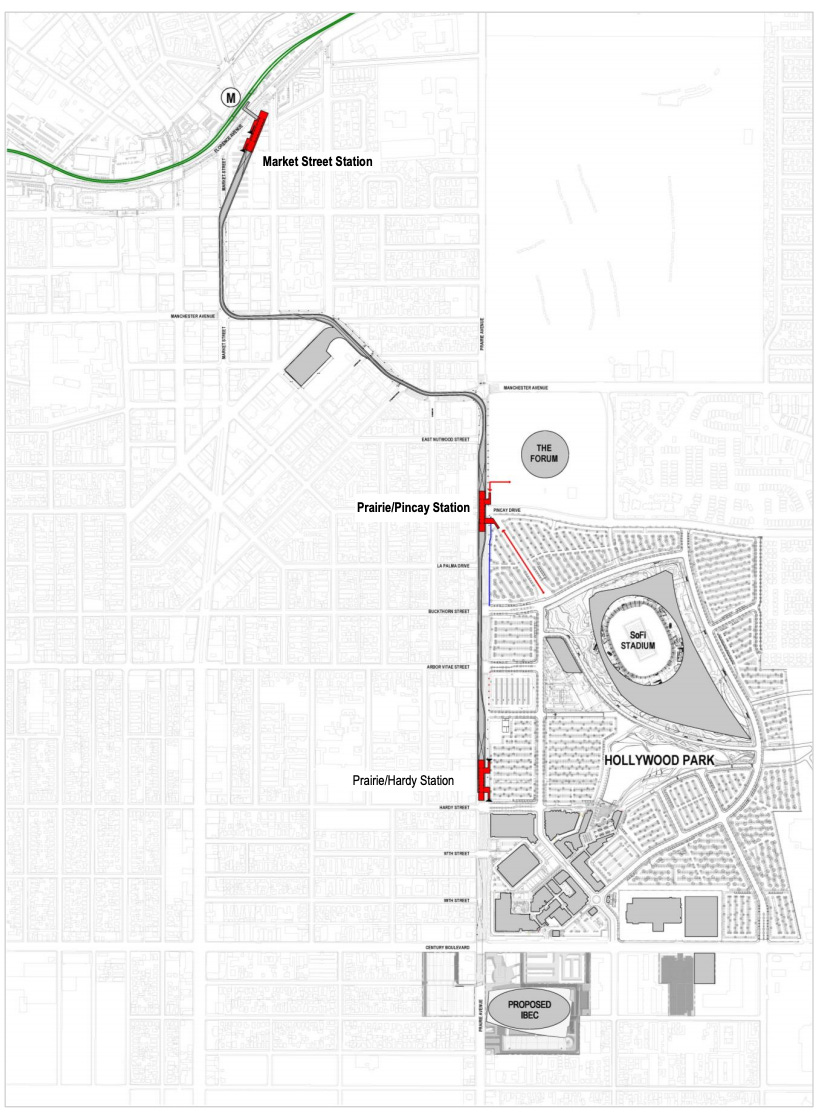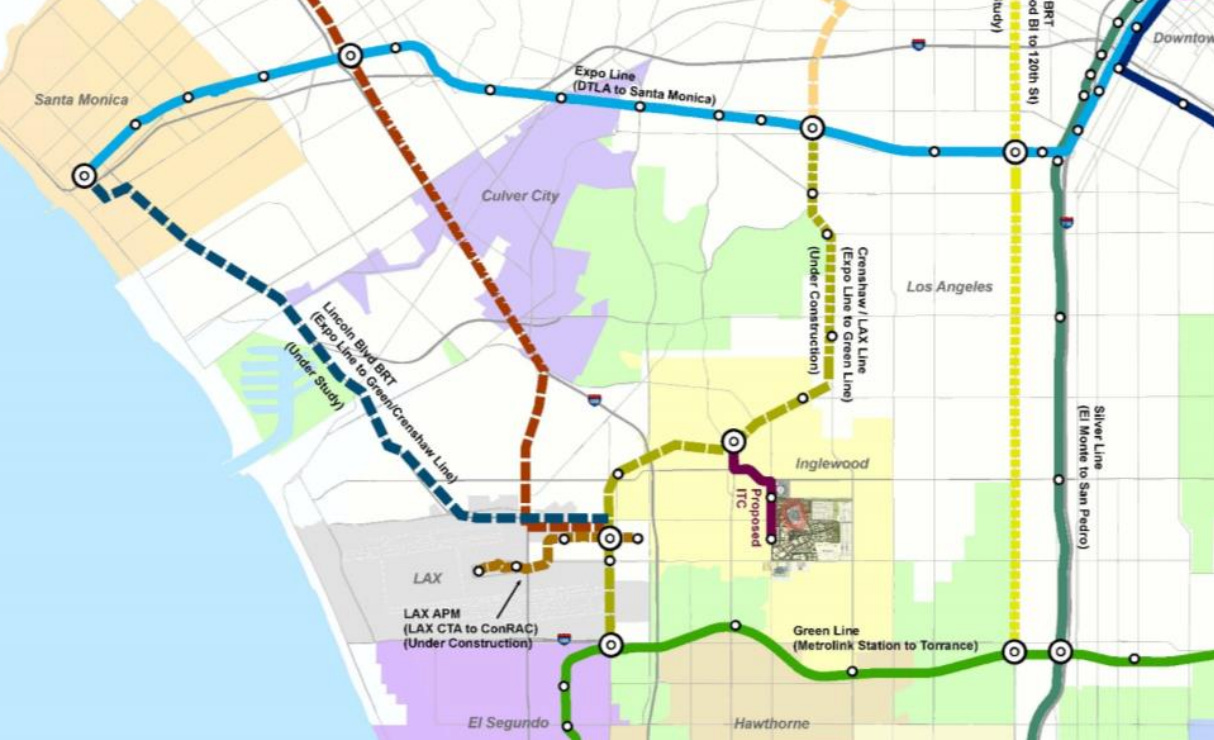We got our hands on Inglewood's grant application for the automated people mover
The self-driving train won't be free.
Right before starting this newsletter, I ate an entire tupperware of cold homemade applesauce in about seven minutes, with a couple three handfuls semi-sweet chocolate chips mixed in. My secret is that I keep the chips chilled. All those months of all those apples, ripening on the tree, gnawed at by the neighborhood scurry, harvested off-branch or off the ground, boiling down in a pot and stirred in on itself, consumed by me like a fire. A fire, a virus, a sports arena. Had me thinking about the swift destruction of great places.
Last week I got very cool reader mail from one of my new paid subscribers:
I would like your permission to use portions of Unstatable written news content concerning the Lakers and Clippers to fashion a voice reel that i could use as a calling card for getting people interested in me as a valid choice for hosting or voicing their own content.
Permission granted! And anyone who reads my newsletter has my endorsement for voiceover roles. You can’t teach taste. Also more people should email me.
Also, more Unstatable stickers went out this week. A few more to go and I’m still working on an Andre Miller sketch for one of the $15+ subs. As a reminder, I send a cool sticker in the mail (it looks like the email header image) to new paid subscribers. A sketch of your fave on greeting card stock if you sponsor me at $15 a month or more.
Thanks to everyone who’s joined along the way.
Financing the Transit Connector is Financing The Arena
A while back I requested the city of Inglewood’s grant application for the automated people mover, formally known as the Inglewood Transit Connector (ITC), through the California Public Records Act. As we covered back in April, the California State Transportation Agency (CalSTA) awarded the city $100 million for the project, a tenth of the projected budget. The ITC would transport people from the Crenshaw Line light-rail station in downtown Inglewood to SoFi Stadium and the Clippers arena.
An automated people mover makes a lot of sense for a <2 mile use-case scenario (in this case it’s about 1.6 miles). It’s fun to ride. It’s fast. It can flex for larger crowds. You don’t have to pay anyone to pilot it. In an earlier newsletter I pointed out that taking transit to Clipper games will become slower and far less convenient for the vast majority of fans when the team moves to Inglewood. (Staples Center is served by light-rail lines that reach as far as Santa Monica and Long Beach, and countless bus routes.) But if an NBA arena is going to be built in Inglewood then it should connect to LA’s rail network so that people don’t have to drive there — which makes the ITC a critical aspect of the infrastructure of the arena itself.
The grant application revealed, among other things, that the city actually requested twice as much as it got. But whether that second hundred million came from the state or the city or from small business fees is secondary to the fact that it will be taxpayers funding the $1 billion project. And that’s just the (estimated) cost of construction! Consider that the Inglewood Basketball and Entertainment Complex (IBEC, and sorry I’m throwing the alphabet at you) will be paid for by Steve Ballmer and also cost a billion dollars. If you agree that the people mover is an essential feature, then the arena is not a one-billion dollar project, as has been generally accepted, nor can it said to be completely privately financed. Instead, the taxpayers are in line to foot a sizable piece of the IBEC bill. It’s hard to say they’re paying exactly half of IBEC because the people mover would also serve SoFi stadium and the Forum — lucrative private investments that hardly benefit the general public — but it is much harder to say they aren’t paying anything.
So, let’s stop calling this a privately financed arena. Financing the automated people mover is financing the arena.
Here’s what else was inside the grant application, which sadly did not contain renderings:
The big stuff
It will be 53 feet above the ground. That’s really high! Maybe higher than any Metro light-rail station? Most of the elevated ones are about 30-40 feet. (I wonder if Slauson is that high. I don’t think it is.)
Three proposed stations, including the one that connects to the Downtown Inglewood light-rail stop. As you can see in the map below, the closest station at Prairie/Hardy will be about four (short) blocks from the IBEC front door. In other words, the Clippers arena is only sort of getting a stop.
Why does it need to be 53 feet high? Well, the three stations will each have three levels — the mezzanine level offering a pedestrian bridge for travelers to cross Prairie, a wide arterial.

The money stuff
Will it at least be free to ride?
…the city’s O&M financial plan assumes a farebox recovery rate of 30%, consistent with urban rail systems, a conservative estimate given the opportunities for premium fare pricing on many event days. The remaining O&M funding needs will come from a combination of City Funds, and project-based revenues, including sale of naming rights for the Project.
Not clear how this will work, but it sounds like the answer is no, the city wants to charge. And it will apparently be priced at a higher rate on game nights? No further detail is offered in the application. Any fee competes with parking and Metro fare is already $1.75 so it couldn’t be more than a dollar or two.
A billion dollars for just 1.6 miles of track? What’s all that money going to?

Transit financing is not my area of expertise but a billion dollars for a mile and a half of track is not a reach — it’s at least in the range of other rail projects. But this one is 53 feet high! So:
How will they pay for it?
In addition to a preexisting regional sales tax funds which are earmarked for transportation projects, the city is proposing throwing in a hundred million or so of its own, which will come from these additional taxes and fees:

As you can see, two of them have to be approved by a 2/3 majority of voters. Maybe this will happen!
The takeaway here is how hard a city has to work to find $100 million. That is an enormous sum of money! Inglewood’s 2019-20 recommended general fund budget reflects annual revenue of $125 million. So, the equivalent of more than 9 months of the city’s revenue would be spent, not on social programs, fixing up roads, planting trees or building parks, but on a monorail that makes it possible for people to take the train an extra mile to football games.
The sexy-if-true stuff
At peak service hours (i.e. on game nights) trains will probably arrive every two-and-a-half minutes.
The city does not commit to the people mover being a monorail or dual-axle. I mean, you’re gonna spend a billion dollars, may as well make it a monorail.
The city claims the people mover will remove “over 2.3 billion vehicle miles traveled [VMT]” over the life of the project. That’s 126,000 VMT per day for 50 years, which seems like a lot of work being done by a 1.6-mile route, with two of its three stops outside sports venues that are closed most of the time.
Out of the projected 2.3 billion vehicle-miles being eliminated, fewer than 200 million (less than 10 percent!) will be provided by the people mover. The operating principle here is that without the people mover providing that last mile and a half, 150 million or so riders wouldn’t get on the rail system for the first 5 or 10 or 30 miles at all.
I mean I get it. If the closest bus stop was a mile and a half from Staples Center, I probably would not bus six miles from my apartment to get there. Would a train that shortened the walk to three-tenths of a mile make it more appetizing? I suppose so.
It’s just hard to see so many people getting on the system from the people mover. The application implies a projected daily ridership of about 19,000 in 2026, by estimating a ridership of 6.9 million total. For comparison, projected daily ridership of the entire Crenshaw Line (scheduled to open in 2021) was between 13,000 and 16,000! Where are all these new riders coming from? Maybe they will live in the football stadium.
And finally…
A neat idea: the application suggests a second phase of the ITC that would connect it southbound to the Green Line. In the below map, it would just be the continuation of that fuchsia line down to the green line. I like this idea because it opens up connections from the arena to the Green Line and Metrolink (a regional rail system). A pipe dream unless the city turns up another billion dollars. Hard to see that happening right now, but you never know. Maybe it will find space for a fourth gigantic entertainment complex!

Blog Roll
Unstatable ∙ Random NBA Play bot ∙ Sideshow Books(Delivering to LA!) ∙ Stealing Home ∙ Same Old Clippers Pod ∙ QuarantineCast with Corbin Smith ∙ Bad Photojournalism ∙ Sports Stories ∙ Bachletter ∙ Basketball Feelings ∙ RealGM Basketball Analysis ∙ The Second Arrangement ∙ Crane In Search Of Man ∙ The Shocker ∙ My Motherfucking LinkedIn Page ∙Fastbreak Breakfast ∙ Prada's Pictures ∙ Roundball Rock ∙ Giri’s Racquet Newsletter ∙ Amazing Blaze ∙ Dreem Team Survivor Recap ∙ In Good Faith ∙ Entrepreneurship Today ∙ Jad's Dad Milo ∙ Mouse House Books


